Honey bee
A honey bee (also spelled honeybee) is a eusocial flying insect within the genus Apis of the bee clade, all native to Eurasia but spread to four other continents by human beings. They are known for construction of perennial, colonial nests from wax, for the large size of their colonies, and for their surplus production and storage of honey, distinguishing their hives as a prized foraging target of many animals, including honey badgers, bears and human hunter-gatherers. Only eight surviving species of honey bee are recognized, with a total of 43 subspecies, though historically seven to 11 species are recognized. Honey bees represent only a small fraction of the roughly 20,000 known species of bees.
| Honey bees | |
|---|---|
 | |
| Western honey bee on the bars of a horizontal top-bar hive | |
| Scientific classification | |
| Kingdom: | Animalia |
| Phylum: | Arthropoda |
| Class: | Insecta |
| Order: | Hymenoptera |
| Family: | Apidae |
| Clade: | Corbiculata |
| Tribe: | Apini Latreille, 1802 |
| Genus: | Apis Linnaeus, 1758 |
| Species | |
| |
The best known honey bee is the western honey bee (Apis mellifera), which has been domesticated for honey production and crop pollination; the only other domesticated bee is the eastern honey bee (Apis cerana), which occurs in South Asia. Some other types of related bees produce and store honey and have been kept by humans for that purpose, including the stingless honey bees, but only members of the genus Apis are true honey bees. Modern humans also value the wax for use in making candles, soap, lip balms, and other products.
Etymology and name
The genus name Apis is Latin for "bee".[1] Although modern dictionaries may refer to Apis as either honey bee or honeybee, entomologist Robert Snodgrass asserts that correct usage requires two words, i.e. honey bee, as it is a kind or type of bee, whereas it is incorrect to run the two words together, as in dragonfly or butterfly, because the latter are not flies,[2] and have no connection with dragons or butter. Honey bee, not honeybee, is the listed common name in the Integrated Taxonomic Information System, the Entomological Society of America Common Names of Insects Database, and the Tree of Life Web Project.[3][4][5]
Origin, systematics, and distribution


Honey bees appear to have their center of origin in South and Southeast Asia (including the Philippines), as all the extant species except Apis mellifera are native to that region. Notably, living representatives of the earliest lineages to diverge (Apis florea and Apis andreniformis) have their center of origin there.[6]
The first Apis bees appear in the fossil record at the Eocene-Oligocene boundary (34 mya), in European deposits. The origin of these prehistoric honey bees does not necessarily indicate Europe as the place of origin of the genus, only that the bees were present in Europe by that time. Few fossil deposits are known from South Asia, the suspected region of honey bee origin, and fewer still have been thoroughly studied.
No Apis species existed in the New World during human times before the introduction of A. mellifera by Europeans. Only one fossil species is documented from the New World, Apis nearctica, known from a single 14 million-year-old specimen from Nevada.[7]
The close relatives of modern honey bees – e.g., bumblebees and stingless bees – are also social to some degree, and social behavior seems a plesiomorphic trait that predates the origin of the genus. Among the extant members of Apis, the more basal species make single, exposed combs, while the more recently evolved species nest in cavities and have multiple combs, which has greatly facilitated their domestication.
Species
While about 20,000 species of bees exist,[8] only eight species of honey bee are recognized, with a total of 43 subspecies, although historically seven to 11 species are recognized:[9] Apis andreniformis (the black dwarf honey bee); Apis cerana (the eastern honey bee); Apis dorsata (the giant honey bee); Apis florea (the red dwarf honey bee); Apis koschevnikovi (Koschevnikov's honey bee); Apis laboriosa (the Himalayan giant honey bee); Apis mellifera (the western honey bee); and Apis nigrocincta (the Philippine honey bee).[10]
Honey bees are the only extant members of the tribe Apini. Today's honey bees constitute three clades: Micrapis (the dwarf honey bees), Megapis (the giant honey bee), and Apis (the western honey bee and its close relatives).[9][11]
Most species have historically been cultured or at least exploited for honey and beeswax by humans indigenous to their native ranges. Only two species have been truly domesticated: Apis mellifera and Apis cerana. A. mellifera has been cultivated at least since the time of the building of the Egyptian pyramids, and only that species has been moved extensively beyond its native range.
Micrapis
Apis florea and Apis andreniformis are small honey bees of southern and southeastern Asia. They make very small, exposed nests in trees and shrubs. Their stings are often incapable of penetrating human skin, so the hive and swarms can be handled with minimal protection. They occur largely sympatrically, though they are very distinct evolutionarily and are probably the result of allopatric speciation, their distribution later converging.
Given that A. florea is more widely distributed and A. andreniformis is considerably more aggressive, honey is, if at all, usually harvested from the former only. They are the most ancient extant lineage of honey bees, maybe diverging in the Bartonian (some 40 million years ago or slightly later) from the other lineages, but do not seem to have diverged from each other a long time before the Neogene.[11] Apis florea have smaller wing spans than its sister species.[12] Apis florea are also completely yellow with the exception of the scutellum of workers, which is black.[12]
Megapis
Two species are recognized in the subgenus Megapis. They usually build single or a few exposed combs on high tree limbs, on cliffs, and sometimes on buildings. They can be very fierce. Periodically robbed of their honey by human "honey hunters", colonies are easily capable of stinging a human being to death if provoked.
- Apis dorsata, the giant honey bee, is native and widespread across most of South and Southeast Asia.
- A. d. binghami, the Indonesian giant honey bee, is classified as the Indonesian subspecies of the giant honey bee or a distinct species; in the latter case, A. d. breviligula and / or other lineages would probably also have to be considered species.[13]
- Apis laboriosa, the Himalayan giant honey bee, was initially described as a distinct species. Later, it was included in A. dorsata as a subspecies[9] based on the biological species concept, though authors applying a genetic species concept have suggested it should be considered a separate species[11] and more recent research has confirmed this classification.[14] Essentially restricted to the Himalayas, it differs little from the giant honey bee in appearance, but has extensive behavioral adaptations that enable it to nest in the open at high altitudes despite low ambient temperatures. It is the largest living honey bee.
Apis
Eastern Apis species include three or four species, including A. koschevnikovi, Apis nigrocincta, and A. cerana. The genetics of the western honey bee (A. mellifera) are unclear.
Koschevnikov's honey bee
Koschevnikov's honey bee (Apis koschevnikovi) is often referred to in the literature as the "red bee of Sabah"; however, A. koschevnikovi is pale reddish in Sabah State, Borneo, Malaysia, but a dark, coppery color in the Malay Peninsula and Sumatra, Indonesia.[15] Its habitat is limited to the tropical evergreen forests of the Malay Peninsula, Borneo and Sumatra and they do not live in tropical evergreen rain forests which extend into Thailand, Myanmar, Cambodia and Vietnam.[15]
Philippine honey bee
Apis nigrocincta is a cavity-nesting species. The species has rust-colored scapes, legs, and clypeuses, with reddish-tan hair color that covers most of the body.[16]
Eastern honey bee
Apis cerana, the eastern honey bee proper, is the traditional honey bee of southern and eastern Asia. One of its subspecies, the Indian honey bee (A. c. indica), was domesticated and kept in hives in a fashion similar to A. mellifera, though on a more limited, regional scale.
It has not been possible yet to resolve its relationship to the Bornean honey bee A. c. nuluensis and Apis nigrocincta from the Philippines to satisfaction; some researchers argue that these are indeed distinct species, but that A. cerana as defined is still paraphyletic, consisting of several separate species,[11] though other researchers argue cerana is a single monophyletic species.[17]
Western honey bee
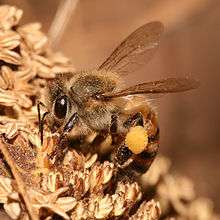
A. mellifera, the most common domesticated[18] species, was the third insect whose genome was mapped. It seems to have originated in eastern tropical Africa and spread from there to Europe and eastwards into Asia to the Tian Shan range. It is variously called the European, western, or common honey bee in different parts of the world. Many subspecies have adapted to the local geographic and climatic environments; in addition, breeds such as the Buckfast bee have been bred. Behavior, color, and anatomy can be quite different from one subspecies or even strain to another.[19]
A. mellifera phylogeny is the most enigmatic of all honey bee species. It seems to have diverged from its eastern relatives only during the Late Miocene. This would fit the hypothesis that the ancestral stock of cave-nesting honey bees was separated into the western group of East Africa and the eastern group of tropical Asia by desertification in the Middle East and adjacent regions, which caused declines of food plants and trees that provided nest sites, eventually causing gene flow to cease.[19]
The diversity of A. mellifera subspecies is probably the product of a largely Early Pleistocene radiation aided by climate and habitat changes during the last ice age. That the western honey bee has been intensively managed by humans for many millennia – including hybridization and introductions – has apparently increased the speed of its evolution and confounded the DNA sequence data to a point where little of substance can be said about the exact relationships of many A. mellifera subspecies.[11]
Apis mellifera is not native to the Americas, so it was not present when the European explorers and colonists arrived. However, other native bee species were kept and traded by indigenous peoples.[20] In 1622, European colonists brought the German honey bee (A. m. mellifera) to the Americas first, followed later by the Italian honey bee (A. m. ligustica) and others. Many of the crops that depend on western honey bees for pollination have also been imported since colonial times. Escaped swarms (known as "wild" honey bees, but actually feral) spread rapidly as far as the Great Plains, usually preceding the colonists. Honey bees did not naturally cross the Rocky Mountains; they were transported by the Mormon pioneers to Utah in the late 1840s, and by ship to California in the early 1850s.[21]

Africanized honey bee
Africanized honey bees (known colloquially as "killer bees") are hybrids between European stock and the East African lowland subspecies A. m. scutellata; they are often more aggressive than European honey bees and do not create as much of a honey surplus, but are more resistant to disease and are better foragers.[22] Accidentally released from quarantine in Brazil, they have spread to North America and constitute a pest in some regions. However, these strains do not overwinter well, so they are not often found in the colder, more northern parts of North America. The original breeding experiment for which the East African lowland honey bees were brought to Brazil in the first place has continued (though not as originally intended). Novel hybrid strains of domestic and re-domesticated Africanized honey bees combine high resilience to tropical conditions and good yields. They are popular among beekeepers in Brazil.
Living and fossil honey bees (Apini: Apis)
Tribe Apini Latreille[23]
Genus Apis Linnaeus (sensu lato)
- henshawi species group (†Priorapis Engel, †Synapis Cockerell)
- †A. vetusta Engel
- †A. henshawi Cockerell
- †A. petrefacta (Říha)
- †A. miocenica Hong
- †A. "longtibia" Zhang
- †A. "Miocene 1"
- armbrusteri species group (†Cascapis Engel)
- †A. armbrusteri Zeuner
- †A. nearctica, species novus
- florea species group (Micrapis Ashmead)
- A. florea Fabricius
- A. andreniformis Smith
- dorsata species group (Megapis Ashmead)
- †A. lithohermaea Engel
- A. dorsata Fabricius
- A. laboriosa Smith
- mellifera species group (Apis Linnaeus sensu stricto)
- mellifera subgroup
- A. mellifera Linnaeus (Apis Linnaeus sensu strictissimo)
- cerana subgroup (Sigmatapis Maa)
- A. cerana Fabricius
- A. nigrocincta Smith
- A. koschevnikovi Enderlein
- mellifera subgroup
Life cycle
As in a few other types of eusocial bees, a colony generally contains one queen bee, a fertile female; seasonally up to a few thousand drone bees, or fertile males;[24] and tens of thousands of sterile female worker bees. Details vary among the different species of honey bees, but common features include:
- Eggs are laid singly in a cell in a wax honeycomb, produced and shaped by the worker bees. Using her spermatheca, the queen can choose to fertilize the egg she is laying, usually depending on which cell she is laying it into. Drones develop from unfertilised eggs and are haploid, while females (queens and worker bees) develop from fertilised eggs and are diploid. Larvae are initially fed with royal jelly produced by worker bees, later switching to honey and pollen. The exception is a larva fed solely on royal jelly, which will develop into a queen bee. The larva undergoes several moultings before spinning a cocoon within the cell, and pupating.
- Young worker bees, sometimes called "nurse bees", clean the hive and feed the larvae. When their royal jelly-producing glands begin to atrophy, they begin building comb cells. They progress to other within-colony tasks as they become older, such as receiving nectar and pollen from foragers, and guarding the hive. Later still, a worker takes her first orientation flights and finally leaves the hive and typically spends the remainder of her life as a forager.
- Worker bees cooperate to find food and use a pattern of "dancing" (known as the bee dance or waggle dance) to communicate information regarding resources with each other; this dance varies from species to species, but all living species of Apis exhibit some form of the behavior. If the resources are very close to the hive, they may also exhibit a less specific dance commonly known as the "round dance".
- Honey bees also perform tremble dances, which recruit receiver bees to collect nectar from returning foragers.
- Virgin queens go on mating flights away from their home colony to a drone congregation area, and mate with multiple drones before returning. The drones die in the act of mating. Queen honey bees do not mate with drones from their home colony.
- Colonies are established not by solitary queens, as in most bees, but by groups known as "swarms", which consist of a mated queen and a large contingent of worker bees. This group moves en masse to a nest site which was scouted by worker bees beforehand and whose location is communicated with a special type of dance. Once the swarm arrives, they immediately construct a new wax comb and begin to raise new worker brood. This type of nest founding is not seen in any other living bee genus, though several groups of vespid wasps also found new nests by swarming (sometimes including multiple queens). Also, stingless bees will start new nests with large numbers of worker bees, but the nest is constructed before a queen is escorted to the site, and this worker force is not a true "swarm".
Gallery
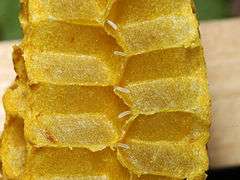 Honey bee eggs shown in opened wax cells
Honey bee eggs shown in opened wax cells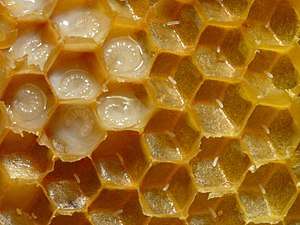 Eggs and larvae
Eggs and larvae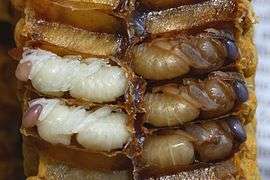 Drone pupae
Drone pupae.jpg) Emergence of a European dark honey bee (A. m. mellifera)
Emergence of a European dark honey bee (A. m. mellifera)
Winter survival
In cold climates, honey bees stop flying when the temperature drops below about 10 °C (50 °F) and crowd into the central area of the hive to form a "winter cluster". The worker bees huddle around the queen bee at the center of the cluster, shivering to keep the center between 27 °C (81 °F) at the start of winter (during the broodless period) and 34 °C (93 °F) once the queen resumes laying. The worker bees rotate through the cluster from the outside to the inside so that no bee gets too cold. The outside edges of the cluster stay at about 8–9 °C (46–48 °F). The colder the weather is outside, the more compact the cluster becomes. During winter, they consume their stored honey to produce body heat. The amount of honey consumed during the winter is a function of winter length and severity, but ranges in temperate climates from 15 to 50 kilograms (33 to 110 lb).[25] In addition, certain bees, including the western honey bee as well as Apis cerana, are known to engage in effective methods of nest thermoregulation during periods of varying temperature in both summer and winter. During the summer, however, this is achieved through fanning and water evaporation from water collected in various fields.[26]
Pollination
Of all the honey bee species, only A. mellifera has been used extensively for commercial pollination of fruit and vegetable crops. The scale of these pollination services is commonly measured in the billions of dollars, credited with adding about 9% to the value of crops across the world. However, despite contributing substantially to crop pollination, there is debate about the potential spillover to natural landscapes and competition between managed honey bees and many of the ~20,000 species of wild pollinators.[27]
Species of Apis are generalist floral visitors, and pollinate many species of flowering plants, but because of their "generalized" nature, they do so inefficiently. Without specialized adaptations for specific flowers, their ability to reach pollen and nectar is often limited. What's more, their tendency to visit all species in a given area means that the pollen they carry for any one species is often very diluted. As such, they can provide some pollination to many plants, especially non-native crops, but most native plants have some native pollinator that is far more effective at pollinating that species.[28] When honey bees are present as an invasive species in an area, they compete for flowers with native pollinators, which can actually push out the native species.[29]
Claims of human dependency
Western honey bees are often described as being essential to all human food production, leading to claims that without their pollination, all of humanity would starve, or even die out.[30][31] Einstein is sometimes misquoted as saying If bees disappeared off the face of the earth, man would only have four years left to live.[32] But not only did the scientist not say that, there is no science to support the prediction itself.[33]
In fact, many important crops need no insect pollination at all. The ten most important crops,[34] comprising 60% of all human food energy,[35] all fall into this category: Plantains are sterile and propagated by cuttings, as are cassava. potatoes, yams, and sweet potatoes are root vegetables propagated by tubers. Soybeans are self-pollinated. Rice, wheat, sorghum, and maize are all wind pollinated, as are most other grasses. [36]
Similarly, no crops originating in the New World depend on the western honey bee (Apis mellifera) at all, as the insect is invasive, having been brought over with colonists in the last few centuries. Tomatoes, peppers, squash, and all other New World crops evolved with native pollinators like squash bees, bumble bees, and other native bees. The stingless bees mentioned by Jefferson are distant relatives of the honey bees, in the genus Melipona.
Nutrition
Honey bees obtain all of their nutritional requirements from a diverse combination of pollen and nectar. Pollen is the only natural protein source for honey bees. Adult worker honey bees consume 3.4–4.3 mg of pollen per day to meet a dry matter requirement of 66–74% protein.[37] The rearing of one larva requires 125-187.5 mg pollen or 25-37.5 mg protein for proper development.[37] Dietary proteins are broken down into amino acids, ten of which are considered essential to honey bees: methionine, tryptophan, arginine, lysine, histidine, phenylalanine, isoleucine, threonine, leucine, and valine. Of these amino acids, honey bees require highest concentrations of leucine, isoleucine, and valine, however elevated concentrations of arginine and lysine are required for brood rearing.[38] In addition to these amino acids, some B vitamins including biotin, folic acid, nicotinamide, riboflavin, thiamine, pantothenate, and most importantly, pyridoxine are required to rear larvae. Pyridoxine is the most prevalent B vitamin found in royal jelly and concentrations vary throughout the foraging season with lowest concentrations found in May and highest concentrations found in July and August. Honey bees lacking dietary pyridoxine were unable to rear brood.[38]

Pollen is also a lipid source for honey bees ranging from 0.8% to 18.9%.[37] Lipids are metabolized during the brood stage for precursors required for future biosynthesis. Fat-soluble vitamins A, D, E, and K are not considered essential but have shown to significantly improve the number of brood reared.[37] Honey bees ingest phytosterols from pollen to produce 24-methylenecholesterol and other sterols as they cannot directly synthesize cholesterol from phytosterols. Nurse bees have the ability to selectively transfer sterols to larvae through brood food.[37]
Nectar is collected by foraging worker bees as a source of water and carbohydrates in the form of sucrose. The dominant monosaccharides in honey bee diets are fructose and glucose but the most common circulating sugar in hemolymph is trehalose which is a disaccharide consisting of two glucose molecules.[39] Adult worker honey bees require 4 mg of utilizable sugars per day and larvae require about 59.4 mg of carbohydrates for proper development.[37]
Honey bees require water to maintain osmotic homeostasis, prepare liquid brood food, and to cool the hive through evaporation. A colony's water needs can generally be met by nectar foraging as it has high water content. Occasionally on hot days or when nectar is limited, foragers will collect water from streams or ponds to meet the needs of the hive.[40]
Beekeeping
The only domesticated species of honey bee are A. mellifera and A. cerana, and they are often maintained, fed, and transported by beekeepers. In Japan, where mellifera is vulnerable to local hornets and disease, the Japanese honey bee a. cerana japonica is used in its place. Modern hives also enable beekeepers to transport bees, moving from field to field as the crop needs pollinating and allowing the beekeeper to charge for the pollination services they provide, revising the historical role of the self-employed beekeeper, and favoring large-scale commercial operations. Bees of various types other than honey bees are also domesticated and used for pollination or other means around the world, including Tetragonula iridipennis in India, the blue orchard bee for tree nut and fruit pollination in the United States, and a number of species of Bombus (bumblebees) for pollination in various regions globally, such as tomatoes, which are not effectively pollinated by honey bees.[41]
Colony collapse disorder
Primarily in places where western honey bees were imported by humans, periodic collapses in western honey bee populations have occurred at least since the late 19th century.[42] Starting in the first decade of the 21st century, abnormally high die-offs (30–70% of hives) of western honey bee colonies have occurred in North America. This has been dubbed "colony collapse disorder" (CCD) and was at first unexplained.[43] It seems to be caused by a combination of factors rather than a single pathogen or poison, possibly including neonicotinoid pesticides[44] or Israeli acute paralysis virus.[45]
Parasites
Galleria mellonella
Larval stages of the moth G. mellonella parasitize both wild and cultivated honey bees, in particular Apis mellifera and Apis cerana. Eggs are laid within the hive, and the larvae that hatch tunnel through and destroy the honeycombs that contain bee larva and their honey stores. The tunnels they create are lined with silk, which entangles and starves emerging bees. Destruction of honeycombs also result in honey leaking and being wasted. Both G. mellonella adults and larvae are possible vectors for pathogens that can infect bees, including the Israeli acute paralysis virus and the black queen cell virus.[46]
To manage the mite, temperature treatments are possible, but also distorts wax of the honeycombs. Chemical fumigants, particularly CO2, are also used.[46]
Bee products
Honey
Honey is the complex substance made when bees ingest nectar, process it, and store the substance into honey combs.[47] All living species of Apis have had their honey gathered by indigenous peoples for consumption. A. mellifera and A. cerana are the only species that have had their honey harvested for commercial purposes.
Beeswax
Worker bees of a certain age secrete beeswax from a series of exocrine glands on their abdomens.[48] They use the wax to form the walls and caps of the comb. As with honey, beeswax is gathered by humans for various purposes such as candle making, waterproofing, soap and cosmetics manufacturing, pharmaceuticals, art, furniture polish and more.[49]
Bee bread
Bees collect pollen in their pollen baskets and carry it back to the hive.[50]
Worker bees combine pollen, honey and glandular secretions and allow it to ferment in the comb to make bee bread. The fermentation process releases additional nutrients from the pollen and can produce antibiotics and fatty acids which inhibit spoilage.[51] Bee bread is eaten by nurse bees (younger workers) which produce the protein-rich royal jelly needed by the queen and developing larvae in their hypopharyngeal glands. In the hive, pollen is used as a protein source necessary during brood-rearing. In certain environments, excess pollen can be collected from the hives of A. mellifera and A. cerana. The product is used as a health supplement. It has been used with moderate success as a source of pollen for hand pollination.
Bee brood
Bee brood – the eggs, larvae or pupae of honey bees – is nutritious and seen as a delicacy in countries such as Indonesia,[52] Mexico, Thailand, and many African countries; it has been consumed since ancient times by the Chinese and Egyptians.[lower-alpha 1][54][55]
Propolis
Propolis is a resinous mixture collected by honey bees from tree buds, sap flows or other botanical sources, which is used as a sealant for unwanted open spaces in the hive.[56] Although propolis is alleged to have health benefits (tincture of Propolis is marketed as a cold and flu remedy), it may cause severe allergic reactions in some individuals.[57] Propolis is also used in wood finishes, and gives a Stradivarius violin its unique red color.[58]
Sexes and castes
Honey bees have three castes: drones, workers, and queens.[63][64] Drones are male, while workers and queens are female.[64]
Drones
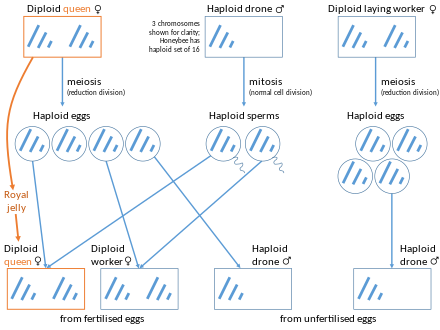
Drones are typically haploid, having only one set of chromosomes, and primarily exist for the purpose of reproduction.[64] They are produced by the queen if she chooses not to fertilize an egg or by an unfertilized laying worker. There are rare instances of diploid drone larvae. This phenomenon usually arises when there are more than two generations of brother-sister mating.[65] Sex determination in honey bees is initially due to a single locus, called the complementary sex determiner (csd) gene. In developing bees, if the conditions are that the individual is heterozygous for the csd gene, they will develop into females. If the conditions are so that the individual is hemizygous or homozygous for the csd gene, they will develop into males. The instances where the individual is homozygous at this gene are the instances of diploid males.[66] Drones take 24 days to develop, and may be produced from summer through to autumn, numbering as many as 500 per hive.[64] They are expelled from the hive during the winter months when the hive's primary focus is warmth and food conservation.[64] Drones have large eyes used to locate queens during mating flights. They do not defend the hive or kill intruders, and do not have a stinger.[67]
Workers
Workers have two sets of chromosomes.[68] They are produced from an egg that the queen has selectively fertilized from stored sperm. Workers typically develop in 21 days. A typical colony may contain as many as 60,000 worker bees.[64] Workers exhibit a wider range of behaviors than either queens or drones. Their duties change upon the age of the bee in the following order (beginning with cleaning out their own cell after eating through their capped brood cell): feed brood, receive nectar, clean hive, guard duty, and foraging.[64][67] Some workers engage in other specialized behaviors, such as "undertaking" (removing corpses of their nestmates from inside the hive).[67]
Workers have morphological specializations, including the pollen basket (corbicula),[69] abdominal glands that produce beeswax, brood-feeding glands, and barbs on the sting. Under certain conditions (for example, if the colony becomes queenless), a worker may develop ovaries.
Worker honey bees perform different behavioural tasks that cause them to be exposed to different local environments.[70][71] The gut microbial composition of workers varies according to the landscape and plant species they forage, such as differences in rapeseed crops,[70] and with different hive tasks, such as nursing or food processing.[71]
Queens
Queen honey bees are created when worker bees feed a single female larvae an exclusive diet of a food called "royal jelly".[64][67] Queens are produced in oversized cells and develop in only 16 days; they differ in physiology, morphology, and behavior from worker bees. In addition to the greater size of the queen, she has a functional set of ovaries, and a spermatheca, which stores and maintains sperm after she has mated. Apis queens practice polyandry, with one female mating with multiple males. The highest documented mating frequency for an Apis queen is in Apis nigrocincta, where queens mate with an extremely high number of males with observed numbers of different matings ranging from 42 to 69 drones per queen.[72] The sting of queens is not barbed like a worker's sting, and queens lack the glands that produce beeswax. Once mated, queens may lay up to 2,000 eggs per day.[67] They produce a variety of pheromones that regulate behavior of workers, and helps swarms track the queen's location during the swarming.[67]
Queen-worker conflict
When a fertile female worker produces drones, a conflict arises between her interests and those of the queen. The worker shares half her genes with the drone and one-quarter with her brothers, favouring her offspring over those of the queen. The queen shares half her genes with her sons and one-quarter with the sons of fertile female workers.[73] This pits the worker against the queen and other workers, who try to maximize their reproductive fitness by rearing the offspring most related to them. This relationship leads to a phenomenon known as "worker policing". In these rare situations, other worker bees in the hive who are genetically more related to the queen's sons than those of the fertile workers will patrol the hive and remove worker-laid eggs. Another form of worker-based policing is aggression toward fertile females.[74] Some studies have suggested a queen pheromone which may help workers distinguish worker- and queen-laid eggs, but others indicate egg viability as the key factor in eliciting the behavior.[75][76] Worker policing is an example of forced altruism, where the benefits of worker reproduction are minimized and that of rearing the queen's offspring maximized.
In very rare instances workers subvert the policing mechanisms of the hive, laying eggs which are removed at a lower rate by other workers; this is known as anarchic syndrome. Anarchic workers can activate their ovaries at a higher rate and contribute a greater proportion of males to the hive. Although an increase in the number of drones would decrease the overall productivity of the hive, the reproductive fitness of the drones' mother would increase. Anarchic syndrome is an example of selection working in opposite directions at the individual and group levels for the stability of the hive.[77]
Under ordinary circumstances the death (or removal) of a queen increases reproduction in workers, and a significant proportion of workers will have active ovaries in the absence of a queen. The workers of the hive produce a last batch of drones before the hive eventually collapses. Although during this period worker policing is usually absent, in certain groups of bees it continues.[78]
According to the strategy of kin selection, worker policing is not favored if a queen does not mate multiple times. Workers would be related by three-quarters of their genes, and the difference in relationship between sons of the queen and those of the other workers would decrease. The benefit of policing is negated, and policing is less favored. Experiments confirming this hypothesis have shown a correlation between higher mating rates and increased rates of worker policing in many species of social hymenoptera.[79]
Defense
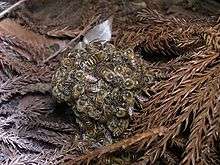
All honey bees live in colonies where the workers sting intruders as a form of defense, and alarmed bees release a pheromone that stimulates the attack response in other bees. The different species of honey bees are distinguished from all other bee species (and virtually all other Hymenoptera) by the possession of small barbs on the sting, but these barbs are found only in the worker bees.
The sting apparatus, including the barbs, may have evolved specifically in response to predation by vertebrates, as the barbs do not usually function (and the sting apparatus does not detach) unless the sting is embedded in fleshy tissue. While the sting can also penetrate the membranes between joints in the exoskeleton of other insects (and is used in fights between queens), in the case of Apis cerana japonica, defense against larger insects such as predatory wasps (e.g. Asian giant hornet) is usually performed by surrounding the intruder with a mass of defending worker bees, which vibrate their muscles vigorously to raise the temperature of the intruder to a lethal level ("balling").[80] Previously, heat alone was thought to be responsible for killing intruding wasps, but recent experiments have demonstrated the increased temperature in combination with increased carbon dioxide levels within the ball produce the lethal effect.[81][82] This phenomenon is also used to kill a queen perceived as intruding or defective, an action known to beekeepers as 'balling the queen', named for the ball of bees formed.
Defense can vary based on the habitat of the bee. In the case of those honey bee species with open combs (e.g., A. dorsata), would-be predators are given a warning signal that takes the form of a "Mexican wave" that spreads as a ripple across a layer of bees densely packed on the surface of the comb when a threat is perceived, and consists of bees momentarily arching their bodies and flicking their wings.[83] In cavity dwelling species such as Apis cerana, Apis mellifera, and Apis nigrocincta, entrances to these cavities are guarded and checked for intruders in incoming traffic. Another act of defense against nest invaders, particularly wasps, is "body shaking," a violent and pendulum like swaying of the abdomen, performed by worker bees.[84]
Venom
The stings of honey bees are barbed and therefore embed themselves into the sting site, and the sting apparatus has its own musculature and ganglion which keep delivering venom even after detachment.[85] The gland which produces the alarm pheromone is also associated with the sting apparatus. The embedded stinger continues to emit additional alarm pheromone after it has torn loose; other defensive workers are thereby attracted to the sting site. The worker dies after the sting becomes lodged and is subsequently torn loose from the bee's abdomen. The honey bee's venom, known as apitoxin, carries several active components, the most abundant of which is melittin,[86] and the most biologically active are enzymes, particularly phospholipase A2.[87]
Honey bee venom is under laboratory and clinical research for its potential properties and uses in reducing risks for adverse events from bee venom therapy,[88] rheumatoid arthritis,[89] and use as an immunotherapy for protection against allergies from insect stings.[90] Bee venom products are marketed in many countries, but, as of 2018, there are no approved clinical uses for these products which carry various warnings for potential allergic reactions.[91]
Competition
With an increased number of honey bees in a specific area due to beekeeping, Western honey bees (as an invasive species) and native wild bees often have to compete for the limited habitat and food sources available,[92] and Western honey bees may become defensive in response to the seasonal arrival of competition from other colonies, particularly Africanized bees which may be on the offence and defence year round due to their tropical origin.[93]
Communication
Honey bees are known to communicate through many different chemicals and odors, as is common in insects. They also rely on a sophisticated dance language that conveys information about the distance and direction to a specific location (typically a nutritional source, e.g., flowers or water). The dance language is also used during the process of reproductive fission, or swarming, when scouts communicate the location and quality of nesting sites.[94]
The details of the signalling being used vary from species to species; for example, the two smallest species, Apis andreniformis and A. florea, dance on the upper surface of the comb, which is horizontal (not vertical, as in other species), and worker bees orient the dance in the actual compass direction of the resource to which they are recruiting.
Carniolan honey bees (Apis mellifera carnica) use their antennae asymmetrically for social interactions, with a strong lateral preference to use their right antennae.[95][96]
There has been speculation as to honey bee consciousness.[97] While honey bees lack the parts of the brain that a human being uses for consciousness like the cerebral cortex or even the cerebrum itself, when those parts of a human brain are damaged, the midbrain seems able to provide a small amount of consciousness. Honey bees have a tiny structure that appears similar to a human midbrain, so if it functions the same way they may possibly be able to achieve a small amount of simple awareness of their bodies.
Symbolism
The bee was used as a symbol of government by Emperor Napoleon I of France.[98] Both the Hindu Atharva Veda[99] and the ancient Greeks associated lips anointed with honey with the gift of eloquence and even of prescience. The priestess at Delphi was the "Delphic Bee".
The Quran has a Sura (chapter) titled "The Bee". It is named after honey bees, and contains a comparison of the industry and adaptability of honey bees to the industry of man.[100]
And your Lord taught the honey bee to build its cells in hills, on trees, and in (men's) habitations; Then to eat of all the produce (of the earth), and find with skill the spacious paths of its Lord: there issues from within their bodies a drink of varying colours, wherein is healing for men: verily in this is a Sign for those who give thought.[101][Quran 16:68]
In ancient Egyptian mythology, honey bees were believed to be born from the tears of the Sun God, Ra.[102]
A community of honey bees has often been employed by political theorists as a model of human society, from Aristotle and Plato to Virgil.[103][104] Honey bees, signifying immortality and resurrection, were royal emblems of the Merovingians. The state of Utah is called the "Beehive State", the state emblem is the beehive, the state insect is the honey bee, and a beehive and the word "industry" appear on both the state flag and seal.[105]
Gallery
- A coloured dot applied by a beekeeper identifies the queen
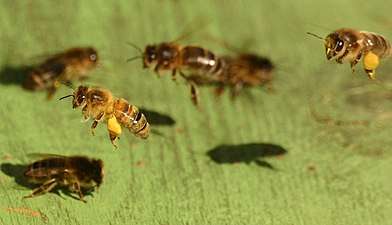 Foragers loaded with pollen on the hive landing board
Foragers loaded with pollen on the hive landing board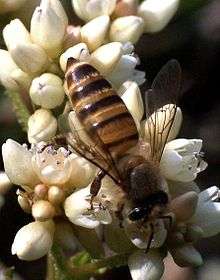 Eastern honey bee (A. cerana) in Hong Kong
Eastern honey bee (A. cerana) in Hong Kong Giant honey bee (A. dorsata)
Giant honey bee (A. dorsata) Honey bee visiting flowers
Honey bee visiting flowers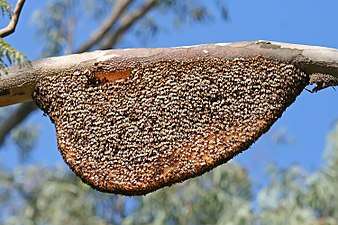 A colony of giant honey bees (A. dorsata) on their comb
A colony of giant honey bees (A. dorsata) on their comb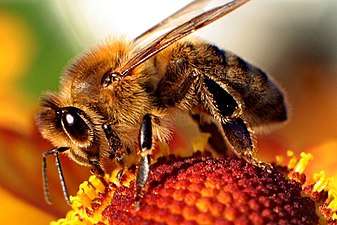 Genus Apis
Genus Apis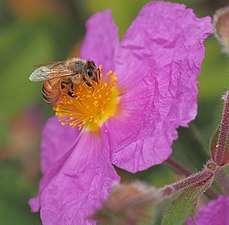 Apis mellifera on rock rose (Cistus) in Oakland, California
Apis mellifera on rock rose (Cistus) in Oakland, California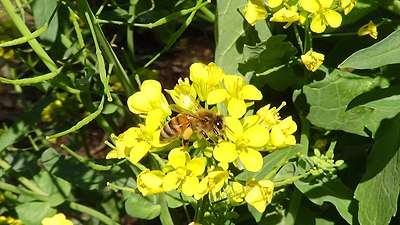 Honey bee collecting pollen from turnip blossoms in Eastern Oklahoma
Honey bee collecting pollen from turnip blossoms in Eastern Oklahoma.jpg) A predator, the green bee-eater
A predator, the green bee-eater
See also
- Bees and toxic chemicals
- Honey bee life cycle
- Honey bee starvation
- More than Honey – a 2012 Swiss documentary film about honey bees
- Melittology, the study of bees
Notes
- The Mayans kept and collected honey and brood, but from stingless social bees such as Melipona beecheii, not from Apis honeybees.[53]
References
- "Honeybee". Online Etymology Dictionary, Douglas Harper. 2019. Retrieved 2016-02-27.
- Robert E. Snodgrass (1984). Anatomy of the Honey Bee. Cornell University Press. p. vii. ISBN 978-0-8014-9302-7.
- "Integrated Taxonomic Information System - Search, Apinae". 2008. Retrieved February 26, 2016.
- "Common Names of Insects Database". Entomological Society of America. Retrieved February 21, 2016.
- "Apinae". Tree of Life Web Project. 2004. Retrieved 2016-02-25.
- Deborah R. Smith; Lynn Villafuerte; Gard Otisc; Michael R. Palmer (2000). "Biogeography of Apis cerana F. and A. nigrocincta Smith: insights from mtDNA studies" (PDF). Apidologie. 31 (2): 265–279. doi:10.1051/apido:2000121. Archived from the original (PDF) on February 29, 2012.
- Michael S. Engel; I. A. Hinojosa-Diaz; A. P. Rasnitsyn (2009). "A honey bee from the Miocene of Nevada and the biogeography of Apis (Hymenoptera: Apidae: Apini)". Proceedings of the California Academy of Sciences. 60 (3): 23–38.
- Nicholls, Henry (15 June 2015). "The truth about bees". BBC. Retrieved 9 July 2020.
- Michael S. Engel (1999). "The taxonomy of recent and fossil honey bees (Hymenoptera: Apidae: Apis)". Journal of Hymenoptera Research. 8: 165–196.
- "Honey Bees". Encyclopedia of Life. Retrieved 9 July 2020.
- Maria C. Arias; Walter S. Sheppard (2005). "Phylogenetic relationships of honey bees (Hymenoptera:Apinae:Apini) inferred from nuclear and mitochondrial DNA sequence data". Molecular Phylogenetics and Evolution. 37 (1): 25–35. doi:10.1016/j.ympev.2005.02.017. PMID 16182149.
Maria C. Arias; Walter S. Sheppard (2005). "Corrigendum to "Phylogenetic relationships of honey bees (Hymenoptera:Apinae:Apini) inferred from nuclear and mitochondrial DNA sequence data"". Molecular Phylogenetics and Evolution. 40 (1): 315. doi:10.1016/j.ympev.2006.02.002. - Wongsiri, S.; et al. (1997). "Comparative biology of Apis andreniformis and Apis florea in Thailand". Bee World. 78 (1): 23–35.
- Nathan Lo; Rosalyn S. Gloag; Denis L. Anderson; Benjamin P. Oldroyd (2009). "A molecular phylogeny of the genus Apis suggests that the Giant Honey Bee of the Philippines, A. breviligula Maa, and the Plains Honey Bee of southern India, A. indica Fabricius, are valid species". Systematic Entomology. 35 (2): 226–233. doi:10.1111/j.1365-3113.2009.00504.x.
- Kitnya N, Prabhudev MV, Bhatta CP, Pham TH, Nidup T, Megu K, Chakravorty J, Brockmann A, Otis GW (2020) Geographical distribution of the giant honey bee Apis laboriosa Smith, 1871 (Hymenoptera, Apidae). ZooKeys 951: 67-81. https://doi.org/10.3897/zookeys.951.49855
- Hadisoesilo, S.; Raffiudin, Rika; Susanti, Wirian; Atmowidi, Tri; Hepburn, Colleen; Radloff, Sarah E.; Fuchs, Stefan; Hepburn, H. Randall (2008-09-01). "Morphometric analysis and biogeography of Apis koschevnikovi Enderlein (1906)". Apidologie. 39 (5): 495–503. doi:10.1051/apido:2008029. ISSN 0044-8435.
- Hadisoesilo, S.; Otis, G. W.; Meixner, M. (1995). "Two distinct populations of cavity-nesting honey bees (Hymenoptera: Apidae) in South Sulawesi, Indonesia". Journal of the Kansas Entomological Society. 68 (4): 399–407. JSTOR 25085613.
- Radloff, Sarah E.; Hepburn, Colleen; Randall Hepburn, H.; Fuchs, Stefan; Hadisoesilo, Soesilawati; Tan, Ken; Engel, Michael S.; Kuznetsov, Viktor (15 March 2010). "Population structure and classification of Apis cerana" (PDF). Apidologie. 41 (6): 589–601. doi:10.1051/apido/2010008.
- "What's Happening To The Bees? - Part 5: Is There A Difference Between Domesticated And Feral Bees?". June 26, 2014.
- Reuber, Brant (February 21, 2015). 21st Century Homestead: Beekeeping (First ed.). lulu.com. p. 116. ISBN 978 1 312 93733 8.
- Villanueva, Rogel; et al. (2005). "Extinction of Melipona beecheii and traditional beekeeping in the Yucatán peninsula". Bee World. 86 (2): 35–41. doi:10.1080/0005772X.2005.11099651.
- Head RJ (2008). "A Brief Survey of Ancient Near Eastern Beekeeping; A Final Note". The FARMS Review. Archived from the original on 2013-07-30. Retrieved 2012-01-16.
- "Africanized honey bee - Apis mellifera scutellata Lepeletier". entnemdept.ufl.edu. Retrieved 2019-05-01.
- Michael S. Engel, Ismael A. Hinojosa-Díaz & Alexandr P. Rasnitsyn (2009). "A honey bee from the Miocene of Nevada and the biogeography of Apis (Hymenoptera: Apidae: Apini)" (PDF). Proceedings of the California Academy of Sciences. 4. 60 (3): 23–38.
- James L. Gould; Carol Grant Gould (1995). The Honey Bee. Scientific American Library. p. 19. ISBN 978-0-7167-6010-8.
- "What do bees do in the winter?". Archived from the original on 4 March 2016. Retrieved 12 March 2016.
- Oldroyd, Benjamin P.; Wongsiri, Siriwat (2006). Asian Honey Bees (Biology, Conservation, and Human Interactions). Cambridge, Massachusetts and London, England: Harvard University Press.ISBN 0674021940.
- Geldmann, Jonas; González-Varo, Juan P. (2018). "Conserving honey bees does not help wildlife". Science. 359 (6374): 392–393. doi:10.1126/science.aar2269. PMID 29371456.
- Plants, Pollinators, and the Price of Almonds
"Flowers set more seeds when visited by wild insects, and the more plants that were visited by wild insects, the more likely they were to set fruit. In some places the researchers considered, wild insects were pollinating most of the plants despite rented honey bees being present." - Saving pollinators is about more than just honeybees
The problem is that there are only so many flowers and places to nest. And once the numbers of honeybees have been artificially inflated (commercial-scale beekeeping wouldn’t exist without humans) the increased competition for these resources can push native non-Apis pollinators out of their natural habitats. Honeybees also spread exotic plants and transmit pathogens, both of which have been shown to harm other pollinators. - "If All The Bees In The World Die, Humans Will Not Survive". Elite Daily.
- A Devastating Look At Our World If Honeybees Disappeared
"A world without honeybees would also mean a world without fruits, vegetables, nuts, and seeds." - What Would Happen if All the Bees Went Extinct?
"First, the easy part: "I've never seen anything definitively link the quote to Einstein," says Mark Dykes, the chief inspector for Texas Apiary Inspection Service. Quote checkers like this one, and this one agree. But debunking its message? That's more complicated." - Would a World Without Bees Be a World Without Us?
"Albert Einstein is sometimes quoted as saying, “If the bee disappears from the surface of the earth, man would have no more than four years to live.” It’s highly unlikely that Einstein said that. For one thing, there’s no evidence of him saying it. For another, the statement is hyperbolic and wrong (and Einstein was rarely wrong)." - Goldschein, Eric. "The 10 Most Important Crops In The World". Business Insider.
- "What Are the World's Most Important Staple Foods?". WorldAtlas.
- Gibson, D.J. Grasses and grassland ecology. Oxford: Oxford University Press. p. 82. ISBN 9780198529187.
- Brodschneider, Robert; Crailsheim, Karl (2010-05-01). "Nutrition and health in honey bees" (PDF). Apidologie. 41 (3): 278–294. doi:10.1051/apido/2010012. ISSN 0044-8435.
- Anderson, Leroy M; Dietz, A. (1976). "Pyridoxine Requirement of the Honey Bee (Apis mellifera) For Brood Rearing". Apidologie. 7: 67–84. doi:10.1051/apido:19760105.
- Karasov, William H.; Martinez del Rio, Carlos (2008). Physiological Ecology: How Animals Process Energy, Nutrients, and Toxins. Princeton. pp. 63–66.
- Kuhnholz, Susanne (1997). "The Control of Water Collection in Honey Bee Colonies". Behavioral Ecology and Sociobiology. 41 (6): 407–422. doi:10.1007/s002650050402.
- "Bumblebee species | Biobest". www.biobestgroup.com.
- Colony Collapse Disorder: The Vanishing Honeybee (Apis Mellifera)
However, as humans continued to manipulate the western honey bee and deliberately transferred them on a global scale, diseases simultaneously spread and harmed managed colonies. Colony losses have occurred periodically throughout history. Fungus, mites, and starvation have all been thought to be the cause of the deaths. The first recorded collapses were called "May Disease" in Colorado in 1891 and 1896. - Bryony, Bonning (11 November 2009). "Honey Bee Disease Overview". Journal of Invertebrate Pathology. 103: S2-4. doi:10.1016/j.jip.2009.07.015. PMID 19909974.
- McDonald-Gibson, Charlotte. "'Victory for bees' as European Union bans neonicotinoid pesticides blamed for destroying bee population". The Independent. Retrieved 2 July 2014.
- "Colony Collapse Disorder". Beeologics. Archived from the original on 6 February 2013. Retrieved 23 October 2014.
- Kwadha, Charles A.; Ong'amo, George O.; Ndegwa, Paul N.; Raina, Suresh K.; Fombong, Ayuka T. (2017-06-09). "The Biology and Control of the Greater Wax Moth, Galleria mellonella". Insects. 8 (2): 61. doi:10.3390/insects8020061. PMC 5492075. PMID 28598383.
- Crane E (1990). "Honey from honeybees and other insects". Ethology Ecology & Evolution. 3 (sup1): 100–105. doi:10.1080/03949370.1991.10721919.
- Sanford, M.T.; Dietz, A. (1976). "The fine structure of the wax gland of the honey bee (Apis mellifera L.)". Apidologie. 7 (3): 197–207. doi:10.1051/apido:19760301.
- "Wax Rendering | Bee Culture". Bee Culture. 2016-03-23. Retrieved 2018-10-26.
- Gillott, Cedric (1995). Entomology. Springer. p. 79.
- Anderson, Kirk E.; Carroll, Mark J.; Sheehan, Tim; Lanan, Michele C.; Mott, Brendon M.; Maes, Patrick; Corby-Harris, Vanessa (5 November 2014). "Hive-stored pollen of honey bees: many lines of evidence are consistent with pollen preservation, not nutrient conversion". Molecular Ecology. 23 (23): 5904–5917. doi:10.1111/mec.12966. PMC 4285803. PMID 25319366.
- Haris, Emmaria (6 December 2013). "Sensasi Rasa Unik Botok Lebah yang Menyengat (Unique taste sensation botok with stinging bees)" (in Indonesian). Sayangi.com. Archived from the original on 2015-06-22. Retrieved 14 February 2018.
- Pearson, Gwen (3 May 2014). "Women Work to Save Native Bees of Mexico". Wired. Retrieved 15 May 2018.
- "How to collect drone larvae from the beehive". Home technologies and practices for small agricultural producers, UN Food and Agriculture Organization. 29 August 2016. Archived from the original on 2018-02-13. Retrieved 2018-02-13.
- Holland, Jennifer (14 May 2013). "U.N. Urges Eating Insects: 8 Popular Bugs to Try". National Geographic.
- Simone-Finstrom, Michael; Spivak, Marla (May–June 2010). "Propolis and bee health: The natural history and significance of resin use by honey bees". Apidologie. 41 (3): 295–311. doi:10.1051/apido/2010016.
- "Propolis:MedlinePlus Supplements". U.S. National Library of Medicine. January 19, 2012.
- Gambichler T; Boms S; Freitag M (April 2004). "Contact dermatitis and other skin conditions in instrumental musicians". BMC Dermatol. 4: 3. doi:10.1186/1471-5945-4-3. PMC 416484. PMID 15090069.
- Jung-Hoffmann, L (1966). "Die Determination von Königin und Arbeiterin der Honigbiene". Z Bienenforsch. 8: 296–322.
- EFSA Panel on Dietetic Products, Nutrition and Allergies, European Food Safety Authority (2011). "Scientific Opinion on the substantiation of health claims related to: anthocyanidins and proanthocyanidins (ID 1787, 1788, 1789, 1790, 1791); sodium alginate and ulva (ID 1873); vitamins, minerals, trace elements and standardised ginseng G115 extract (ID 8, 1673, 1674); vitamins, minerals, lysine and/or arginine and/or taurine (ID 6, 1676, 1677); plant-based preparation for use in beverages (ID 4210, 4211); Carica papaya L. (ID 2007); "fish protein" (ID 651); acidic water-based, non-alcoholic flavoured beverages containing calcium in the range of 0.3 to 0.8 mol per mol of acid with a pH not lower than 3.7 (ID 1170); royal jelly (ID 1225, 1226, 1227, 1228, 1230, 1231, 1326, 1328, 1329, 1982, 4696, 4697); foods low in cholesterol (ID 624); and foods low in trans-fatty acids (ID 672, 4333) pursuant to Article 13(1) of Regulation (EC) No 1924/2006". EFSA Journal. 9 (4): 2083. doi:10.2903/j.efsa.2011.2083.CS1 maint: multiple names: authors list (link)
- "Federal Government Seizes Dozens of Misbranded Drug Products: FDA warned company about making medical claims for bee-derived products". Food and Drug Administration. Apr 5, 2010.
- Leung, R; Ho, A; Chan, J; Choy, D; Lai, CK (March 1997). "Royal jelly consumption and hypersensitivity in the community". Clin. Exp. Allergy. 27 (3): 333–6. doi:10.1111/j.1365-2222.1997.tb00712.x. PMID 9088660.
- "Bee castes". Visual Dictionary, QA International. 2017. Retrieved 18 May 2017.
- "Getting Started: Honey Bee Biology". University of Georgia College of Agricultural and Environmental Sciences. 2017. Retrieved 18 May 2017.
- Woyka, J.; Pszczelnictwa, Zaklad; Drone Larvae from Fertilized Eggs of the Honey Bee Journal of Apiculture Research, (1963), pages 19-24
- Weinstock, George M.; Robinson, Gene E., & the Honeybee Genome Sequencing Consortium Insights into social insects from the genome of the honeybee Apis mellifera Nature, volume "'443'" (2006), pages 931-949
- "Worker, drone and queen bees". PerfectBee LLC. 2017. Retrieved 18 May 2017.
- Harbo JR, Rinderer TE (1980). "Breeding and Genetics of Honey Bees". Beesource Beekeeping. Retrieved 18 May 2017.
- "Morphology of a honeybee: worker". Visual Dictionary, QA International. 2017. Retrieved 18 May 2017.
- Jones, Julia C; Fruciano, Carmelo; Hildebrand, Falk; Al Toufalilia, Hasan; Balfour, Nicholas J; Bork, Peer; Engel, Philipp; Ratnieks, Francis LW; Hughes, William OH (2018). "Gut microbiota composition is associated with environmental landscape in honey bees". Ecology and Evolution. 8 (1): 441–451. doi:10.1002/ece3.3597. PMC 5756847. PMID 29321884.
- Jones, J. C; Fruciano, C; Marchant, J; Hildebrand, F; Forslund, S; Bork, P; Engel, P; Hughes, W. O. H (2018). "The gut microbiome is associated with behavioural task in honey bees". Insectes Sociaux. 65 (3): 419–429. doi:10.1007/s00040-018-0624-9. PMC 6061168. PMID 30100619.
- Hadisoesilo, Soesilawati. "The Comparative Study of Two Species of Cavity-Nesting Honey Bees of Sulawesi, Indonesia" (PDF).
- Wenseleers, T.; Helanterä, H.; Hart, A.; Ratnieks, F. L. W. (2004). "Worker reproduction and policing in insect societies: an ESS analysis". Journal of Evolutionary Biology. 17 (5): 1035–1047. doi:10.1111/j.1420-9101.2004.00751.x. PMID 15312076.
- Ratnieks, F.; Visscher, P. Kirk (1989). "Worker policing in the honeybee". Nature. 342 (6251): 796–797. Bibcode:1989Natur.342..796R. doi:10.1038/342796a0.
- Pirk, C.; Neumann, P.; Hepburn, R.; Moritz, R.; Tautz, J. (2003). "Egg viability and worker policing in honey bees". PNAS. 101 (23): 8649–8651. Bibcode:2004PNAS..101.8649P. doi:10.1073/pnas.0402506101. PMC 423249. PMID 15169961.
- Oldroyd, B.; Ratnieks, Francis (2002). "Egg-marking pheromones in honey-bees Apis mellifera". Behavior Ecology and Sociobiology. 51: 590–591. doi:10.1007/s00265-002-0480-4.
- Barron, A.; Oldroyd, B; Ratnieks, F.L.W. (2001). "Worker reproduction in honey-bees (Apis) and the anarchic syndrome: a review". Behavior Ecology and Sociobiology. 50: 199–208. doi:10.1007/s002650100362.
- Châline, N.; Martin, S.J.; Ratnieks, F.L.W. "Worker policing persists in a hopelessly queenless honey bee colony (Apis mellifera)". Insectes Soc. 51: 1–4. doi:10.1007/s00040-003-0708-0.
- Davies, N.R., Krebs, J.R., and West, S.A. An Introduction to Behavioral Ecology. 4th ed. West Sussex: Wiley-Blackwell, 2012. Print. pp. 387–388
- C. H. Thawley. "Heat tolerance as a weapon". Davidson College. Archived from the original on October 2, 2013. Retrieved June 1, 2010.
- Michio Sugahara; Fumio Sakamoto (2009). "Heat and carbon dioxide generated by honeybees jointly act to kill hornets". Naturwissenschaften. 96 (9): 1133–6. Bibcode:2009NW.....96.1133S. doi:10.1007/s00114-009-0575-0. PMID 19551367.
- Victoria Gill (July 3, 2009). "Honeybee mobs overpower hornets". BBC News. Retrieved July 5, 2009.
- "Giant Honeybees Use Shimmering 'Mexican Waves' To Repel Predatory Wasps". ScienceDaily.
- Radloff, Sara E.; Hepburn, H. Randall; Engel, Michael S. (2011). Honeybees of Asia. Berlin: Springer Science & Business Media. ISBN 978-3642164217.
- Biller, Jose; Ferro, Jose M (7 February 2014). Neurologic Aspects of Systemic Disease, Part II (1st ed.). Elsevier. p. 995. ISBN 9780702040870.
- Chen J, Guan SM, Sun W, Fu H (2016). "Melittin, the Major Pain-Producing Substance of Bee Venom". Neuroscience Bulletin. 32 (3): 265–72. doi:10.1007/s12264-016-0024-y. PMC 5563768. PMID 26983715.
- Ramanadham, S; Ali, T; Ashley, J. W; Bone, R. N; Hancock, W. D; Lei, X (2015). "Calcium-independent phospholipases A2 and their roles in biological processes and diseases". Journal of Lipid Research. 56 (9): 1643–1668. doi:10.1194/jlr.R058701. PMC 4548770. PMID 26023050.
- Park, J. H; Yim, B. K; Lee, J. H; Lee, S; Kim, T. H (2015). "Risk Associated with Bee Venom Therapy: A Systematic Review and Meta-Analysis". PLOS ONE. 10 (5): e0126971. doi:10.1371/journal.pone.0126971. PMC 4440710. PMID 25996493.
- Lee, J. A; Son, M. J; Choi, J; Jun, J. H; Kim, J. I; Lee, M. S (2014). "Bee venom acupuncture for rheumatoid arthritis: A systematic review of randomised clinical trials". BMJ Open. 4 (11): e006140. doi:10.1136/bmjopen-2014-006140. PMC 4225238. PMID 25380812.
- Boyle, R. J; Elremeli, M; Hockenhull, J; Cherry, M. G; Bulsara, M. K; Daniels, M; Oude Elberink, J. N (2012). "Venom immunotherapy for preventing allergic reactions to insect stings" (PDF). Cochrane Database of Systematic Reviews. 10: CD008838. doi:10.1002/14651858.CD008838.pub2. PMID 23076950.
- "Wasp and Bee venom". Drugs.com. 2018. Retrieved 29 June 2018.
- Hudewenz, Anika; Klein, Alexandra-Maria (2013-12-01). "Competition between honey bees and wild bees and the role of nesting resources in a nature reserve". Journal of Insect Conservation. 17 (6): 1275–1283. doi:10.1007/s10841-013-9609-1. ISSN 1366-638X.
- Johnson, Brian R.; Nieh, James C. (2010-11-01). "Modeling the Adaptive Role of Negative Signaling in Honey Bee Intraspecific Competition". Journal of Insect Behavior. 23 (6): 459–471. doi:10.1007/s10905-010-9229-5. ISSN 0892-7553. PMC 2955239. PMID 21037953.
- Tarpy, David (2016). "The Honey Bee Dance Language". NC State Extension.
- Rogers, Lesley J.; Elisa Rigosi; Elisa Frasnelli; Giorgio Vallortigara (27 June 2013). "A right antenna for social behaviour in honeybees". Scientific Reports. 3: 2045. Bibcode:2013NatSR...3E2045R. doi:10.1038/srep02045. PMC 3694496. PMID 23807465.
- Jessica Shugart. "Honeybees use right antennae to tell friend from foe". Science News. Retrieved 12 March 2016.
- Gorman, James (18 April 2016). "Do Honeybees Feel? Scientists Are Entertaining the Idea" – via NYTimes.com.
- "The symbols of empire". Napoleon.org. Retrieved June 1, 2010.
- "O Asvins, lords of brightness, anoint me with the honey of the bee, that I may speak forceful speech among men! Atharva Veda 91–258, quoted in Maguelonne Toussaint-Samat (Anthea Bell, tr.) The History of Food, 2nd ed. 2009:14.
- "THE HONEY BEE". www.islamicity.com.
- "Honey Bees in Quran". www.miracles-of-quran.com.
- Holly Norton (24 May 2017). "Honey, I love you: our 40,000-year relationship with the humble bee". The Guardian. Retrieved 29 June 2018.
- Virgil, Georgics, book IV.
- Bee Wilson (2004). The Hive: The Story of the Honeybee. London: John Murray. p. 14. ISBN 978-0-7195-6598-4.
- "Utah State Motto and Emblem". Utah State Library. Retrieved 2017-10-13.
External links
| Wikimedia Commons has media related to Apis (insect). |
| Look up honey bee in Wiktionary, the free dictionary. |
| Wikispecies has information related to Apis |
- Could a Mushroom Save a Honeybee? Documentary produced by Oregon Field Guide, 14 October 2015